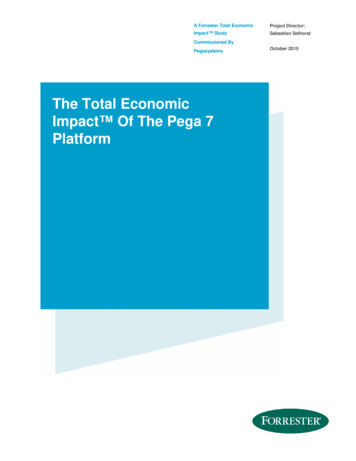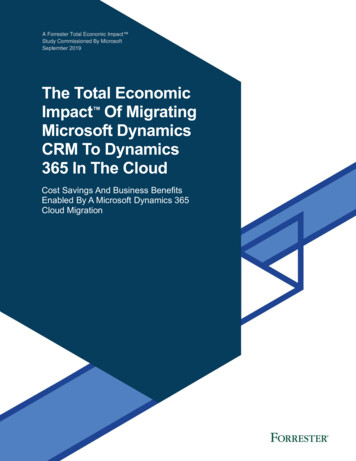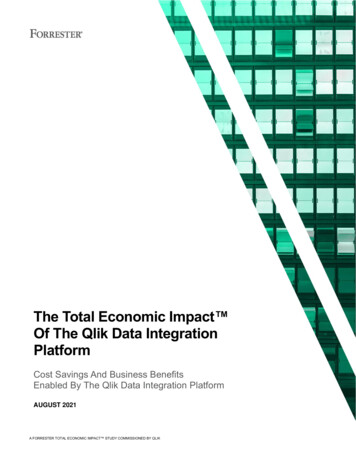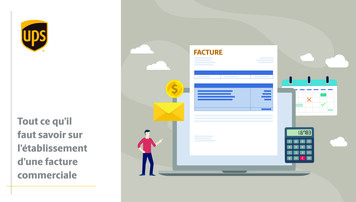
Transcription
A Forrester Total EconomicProject Director:Impact StudySebastian SelhorstCommissioned ByPegasystemsThe Total EconomicImpact Of The Pega 7PlatformOctober 2015
Table Of ContentsExecutive Summary . 3Disclosures . 5TEI Framework And Methodology . 6Analysis . 7Financial Summary . 25The Pega 7 Platform: Overview . 26Appendix A: Composite Organization Description . 27Appendix B: Total Economic Impact Overview. 28Appendix C: Glossary. 29Appendix D: Supplemental Material . 30Appendix E: Endnotes . 30ABOUT FORRESTER CONSULTINGForrester Consulting provides independent and objective research-basedconsulting to help leaders succeed in their organizations. Ranging in scope from ashort strategy session to custom projects, Forrester’s Consulting services connectyou directly with research analysts who apply expert insight to your specificbusiness challenges. For more information, visit forrester.com/consulting. 2015, Forrester Research, Inc. All rights reserved. Unauthorized reproduction is strictly prohibited.Information is based on best available resources. Opinions reflect judgment at the time and are subject tochange. Forrester , Technographics , Forrester Wave, RoleView, TechRadar, and Total Economic Impactare trademarks of Forrester Research, Inc. All other trademarks are the property of their respectivecompanies. For additional information, go to www.forrester.com.
3Executive SummaryToday, companies waste a lot of money on ineffective andinefficient business processes that also result in suboptimalcustomer experiences. More and more, these companies realizethat they need to provide better flexibility and agility to quicklychange processes based on new competitive and economic threatsand opportunities.Pegasystems commissioned Forrester Consulting to conduct aTotal Economic Impact (TEI) study and examine the potentialreturn on investment (ROI) enterprises may realize by deployingthe Pega 7 Platform. The purpose of this study is to provide readerswith a framework to evaluate the potential financial impact of thePega 7 Platform on their organizations. This business caseanalyzes the value of developing business applications on thePega 7 Platform as compared with using a more traditionaldevelopment approach.“The Pega 7 platform enablesus to develop flexible businessapplications with fewerresources and in only afraction of the time. It alsoprovides us with analyticalcapabilities while protectingour existing assets.” Front office program director, global insurancecompanyThe Pega 7 Platform is an application development platformintended for large enterprises seeking to build, deploy, and evolvestrategic business applications. The platform can be deployed on1premises or in the Pega Cloud.To better understand the benefits, costs, and risks associated with a Pega 7 Platform implementation, Forrester interviewedfour customers from the private and public sector that had extensive experience using the Pega 7 Platform.The interviews revealed the challenges that these organizations had with their previous development environments, usingcommon programming languages with older development techniques. They found it hard to reconcile long developmentcycles with quickly changing requirements triggered by, for example, changing regulations, shifting market dynamics, orevolving customer expectations. These interviews also demonstrated how an application development platform like thePega 7 solution might help address these challenges.THE PEGA 7 PLATFORM HELPS LARGE ORGANIZATIONS GAIN AGILITY WHILE REDUCING DEVELOPMENTCOSTSForrester interviewed four existing customers and built a composite organization based on the characteristics of the2interviewed companies. This composite company experienced the risk-adjusted benefits and costs summarized in Figure31. The composite organization analysis saw approximately 33.6 million in benefits versus costs of 8 million, which addedup to a net present value (NPV) of 25.6 million over the three years of the analysis. The interviewed organizations reportedthat compared with their previous development practices, the development costs for a strategic business applicationdecreased by 75% and the average time-to-market was reduced by 50%.FIGURE 1Financial Summary Showing Three-Year Risk-Adjusted ResultsROI:321%Source: Forrester Research, Inc.NPV: 25.6 millionDevelopmentcosts: 75%Time-to-market: 50%
4››Benefits. The organization used in this analysis is a composite based on interviews that Forrester conducted with fourPegasystems customers to delve more deeply into the financial impact of the Pega 7 Platform. The compositeorganization, which serves here as an example, represents a Global 2000 organization providing communications4services. The company wanted to improve its customer engagement practices and saw the opportunity to leverage newbusiness process management (BPM) and case management capabilities in order to better engage with customers as wellas create internal efficiencies. Prior to deploying the Pega 7 Platform, the company used common programminglanguages with older development techniques. As a result of switching to the Pega 7 Platform, the organization realizedthe following risk-adjusted benefits that represent those experienced by the interviewed Pegasystems customers. The totalbenefits have a risk-adjusted present value of 33.6 million over the three years of the analysis. The benefits include: Development cost savings of 75%. With the adoption of the Pega 7 Platform, all of the interviewed organizationstransitioned from traditional programming languages with older development techniques to a model-driven approachwith Agile methodologies. Interviewees reported that despite higher average bill rates for developers with Pegaskills, their organizations achieved significant development cost savings due to, for example, improved reusability,better collaboration between the business and IT enabled by capabilities such as Directly Capture Objectives (DCO),ease of integration, and fast user interface developments. To build a business application, the compositeorganization in this example requires three times less resources, and the projects are executed in half of the time onaverage. The development costs avoided represent 54% of the total benefits for the composite organization. Increased agility or change-related development cost savings of 75%. The interviewed organizations reportedthat the Pega 7 Platform, through its model-driven approach and reusability of components such as the SituationalLayer Cake, made their business applications more flexible. The business is taking over the ownership of changesand evolutions from the IT department. For the composite organization, changes are now faster and easier toimplement, making it possible to quickly adjust to changing internal or external requirements or shifting marketimperatives. The improved agility represents 11% of the total benefits quantified in this case study. Reduced time-to-market by 50%. With the Pega 7 Platform, the interviewed organizations observed developmenttimes two to five times shorter as compared with their previous development environment and practices. Thisanalysis assumes that the composite organization is able to launch its new business applications 90 days earlier,and thus realize truly incremental value from the following business benefits as compared with the alternativescenario, where the same business applications would have been developed with the previous, more traditionaldevelopment approach. The reduced time-to-market represents 35% of the total benefits in this case study andresults in the following benefits:oEnd user productivity gains. Interviewees reported that their end users had typically achieved 20%to 50% in productivity gains as compared with their previous, manual processes; in specific casesthey even achieved up to 75% in productivity gains. Over the three years of the analysis, thecomposite organization deploys 15 business applications. Per application, an average of 200 endusers become 50% more productive and can allocate the saved time for more value-add tasks.oIncremental revenue. Interviewees also gave examples of millions of dollars’ worth of increasedrevenues, reduced cancellation rates, or improved customer engagement. For the compositeorganization, we assume that the business applications have a direct impact on revenue generation.Due to the Pega 7 Platform, the company is able to capture 90 days of incremental revenue, thusresulting in incremental profit. Only the incremental profit as opposed to entire incremental revenuewith business applications is quantified in the time-to-market benefits.Costs. The composite organization decided to deploy the Pega 7 Platform on-premises and experienced the followingincremental costs that have a risk-adjusted present value of 8 million over the three years of the analysis. Organizationsshould also evaluate the option of using the Pega Cloud instead; an annual subscription fee would replace the softwarelicense, infrastructure, and some of the installation-related costs detailed below. The costs include:
5 Software costs. These costs are the estimated software license and maintenance costs for the Pega 7 Platform forthe composite organization and represent 20% of the total costs. Infrastructure-related costs. These costs cover the server hardware, hardware maintenance, and hosting costs forthe composite organization and represent 2% of the total costs. Initial setup and ongoing administration and support costs. These costs represent 1% of the total costs andtake into account the initial deployment of the Pega 7 Platform as well as the incremental ongoing administration andsupport efforts. Development costs. Over the three years of the analysis, the composite organization develops and deploys 13 newbusiness applications on the Pega 7 Platform. These costs cover the assumed development costs and represent75% of the total costs. Training costs. The composite organization invests in training to make internal resources proficient with the newdevelopment environment and techniques. The training costs represent 2% of the total costs.DisclosuresThe reader should be aware of the following:›The study is commissioned by Pegasystems and delivered by Forrester Consulting. It is not meant to be used as acompetitive analysis.›Forrester makes no assumptions as to the potential ROI that other organizations will receive. Forrester strongly advisesthat readers use their own estimates within the framework provided in the report to determine the appropriateness of aninvestment in the Pega 7 Platform.›Pegasystems reviewed and provided feedback to Forrester, but Forrester maintains editorial control over the study and itsfindings and does not accept changes to the study that contradict Forrester's findings or obscure the meaning of the study.›Pegasystems provided the customer names for the interviews but did not participate in the interviews.
6TEI Framework And MethodologyINTRODUCTIONFrom the information provided in the interviews, Forrester constructed a Total Economic Impact (TEI) framework for thoseorganizations considering implementing the Pega 7 Platform. The objective of the framework is to identify the cost, benefit,flexibility, and risk factors that affect the investment decision, to help organizations understand how to take advantage ofspecific benefits, reduce costs, and improve the overall business goals of winning, serving, and retaining customers.APPROACH AND METHODOLOGYForrester took a multistep approach to evaluate the impact that the Pega 7 Platform can have on an organization (see Figure2). Specifically, we:›Interviewed Pegasystems marketing, sales, and/or consulting personnel, along with Forrester analysts, to gather datarelative to the Pega 7 Platform and the marketplace for the Pega 7 Platform.›Interviewed four organizations currently using the Pega 7 Platform to obtain data with respect to costs, benefits, and risks.›Designed a composite organization based on characteristics of the interviewed organizations (see Appendix A).›Constructed a financial model representative of the interviews using the TEI methodology. The financial model ispopulated with the cost and benefit data obtained from the interviews as applied to the composite organization.›Risk-adjusted the financial model based on issues and concerns the interviewed organizations highlighted in interviews.Risk adjustment is a key part of the TEI methodology. While interviewed organizations provided cost and benefitestimates, some categories included a broad range of responses or had a number of outside forces that might haveaffected the results. For that reason, some cost and benefit totals have been risk-adjusted and are detailed in eachrelevant section.Forrester employed four fundamental elements of TEI in modeling the impact of the Pega 7 Platform: benefits, costs,flexibility, and risks.Given the increasing sophistication that enterprises have regarding ROI analyses related to IT investments, Forrester’s TEImethodology serves to provide a complete picture of the total economic impact of purchase decisions. Please see AppendixB for additional information on the TEI methodology.FIGURE 2TEI ApproachPerformdue diligenceSource: Forrester Research, zationConstructfinancialmodel usingTEI frameworkWritecase study
7AnalysisINTERVIEW HIGHLIGHTSFor this study, Forrester conducted a total of four interviews with representatives from the following large organizations,which are Pegasystems customers and are using the Pega 7 Platform for transformational projects:›A public sector organization. This US public sector organization has about 13,000 employees. One of its challenges wasthat it had many redundant IT systems and applications. The maintenance of these systems was consuming 85% of theentire IT budget, leaving very limited funds for new projects. The main objectives for introducing the Pega platform — apartfrom reducing the overall maintenance costs and freeing up budget for new initiatives — were to improve the service to thecitizens, gain visibility into business processes, and create internal efficiencies. In December 2013, the organizationmigrated from Pega 6 to the Pega 7 Platform operated in the Pega Cloud. At the time of the interview, the organization haddeployed eight applications in production on the Pega 7 Platform and six more projects were about to be released. Thebusiness applications were generally around licensing and permitting requests, internal operations in the enterpriseresource planning (ERP) system, or going paperless.›A leading technology company. The technical services arm of this global technology company with more than 70,000employees based in the US saw the opportunity to create case management and business process managementcapabilities. Its heavily customized enterprise resource planning (ERP) system made it difficult to extract and analyze data.In 2013, the organization decided to deploy the Pega 7 Platform on-premises in order to build out business processesrelated to service management functions such as incident, problem, or asset management. The ERP system is maintainedas a system of record, but Pega is used to take out the complexity of the customized ERP environment and bring visibilityinto the business processes. At the time of the interview, the company had 10 business applications in production on thePega platform and many more projects in the pipeline.›A large financial services organization. A division of a Western European financial services organization with more than60,000 employees wanted to move into a new market segment and needed to develop a new multitenant casemanagement and fulfillment platform. Due to ever-changing and evolving regulations in the banking sector, the solutionhad to be very flexible. A short time-to-market and general scalability were other important requirements. The organizationintroduced Pega 7 on-premises in 2014. The initial development took between three and four months. At the time of theinterview, the company had one active customer on the newly developed platform and was in the process of rolling thenew services out to three more clients.›A leading global insurance company. A division of a global insurance company with more than 100,000 employees andheadquarters in Western Europe was looking for a technical solution to better support customer-facing functions. Its clientfacing staff was using a number of redundant and siloed applications. Users had to key in data to various systems,resulting in challenges around process transparency and staff efficiency. The organization decided to deploy the Pega 7Platform on-premises in July 2014. The development of the first business application took about 10 months. The solutionthat is related to one product offering was rolled out in 15 countries simultaneously, and the company has plans to addother business segments in the near future.COMPOSITE ORGANIZATIONFor this financial case study, Forrester has created a composite organization to illustrate the quantifiable costs and benefitsof using the Pega 7 Platform. Forrester’s conclusions were derived in large part from information received in a series of indepth interviews with executives and personnel at the four organizations described above. As each of the interviewedorganizations was promised anonymity, Forrester constructed a composite company, a TEI framework, and an associatedROI analysis based on our findings from these Pegasystems clients.
8The composite organization represents a Global 2000 organization. The company employs about 10,000 people worldwideand provides communications services.SituationThe composite organization was looking to transform into a digital enterprise to better engage with its customers, buildefficient operations, and quickly respond to changes in the market. However, there was an execution gap between how theywanted to engage with customers and the capabilities of the existing systems. Many of the company’s internal practiceswere still very manual or relying on rigid and unintegrated point solutions. The company’s ERP was heavily customized,which made it difficult to extract and analyze data as well as optimize an end-to-end process.The company wanted to improve its customer engagement and saw the opportunity to create new BPM, case management,mobile, social, and decision analytics capabilities in order to better engage with customers as well as create internalefficiencies.Prior to deploying the Pega 7 Platform and similar to the interviewed customers, the company used common programminglanguages with older development techniques. The company was looking for a flexible, scalable, and modern enterpriseplatform that would provide predefined strategic applications and could easily be integrated with existing systems.SolutionAfter having evaluated different options, the organization chose to deploy the Pega 7 Platform on-premises. With thetransition to an Agile development practice, the company wanted to reduce the implementation risks, improve the quality ofthe application delivery, and increase the flexibility of the applications.The development of the first business application took about fourmonths and was executed by a team of 15 people, includinginternal resources and external consultants. Over time, as thecompany developed more and more applications on the Pega 7Platform, the teams got smaller and the average length of theprojects grew shorter.ResultsWhile the interviewed organizations had very different use cases,they all see great value in using the Pega 7 Platform. Theinterviews with these Pega customers revealed that:›The Pega 7 Platform has a comprehensive set ofcapabilities. The interviewed organizations, which representdifferent industries, did not just want to add another businessprocess or case management tool as a point solution. They werelooking for a single and flexible platform to build enterprise-classapplications for their front and back office processes. Theyappreciated the mobile, social, and analytical capabilities of thePega 7 Platform, as well as the prebuilt frameworks and strategicapplications.“One of the big constraints wehad was time-to-market. Weneeded to develop a brand newsystem within a three-monthperiod. That was generallyperceived at the time to behighly aggressive. I think wecommenced the project withPega at the beginning of May[2014], and we had it in placeactually just around Fourth ofJuly.” Senior IT manager, large financial servicescompany
9“We were looking for a modern, flexible enterprise platform that would facilitate our business processes, supportdifferent devices and channels, protect our existing assets, and come with frameworks with predefined functions sothat we would not have to start from scratch. The Pega 7 Platform seemed like the best match for us.” Front office program director, global insurance company›There is still a lot of potential in increasing efficiency of business processes. Even though business process andcase management practices have been around for many years, the interviewees recognized inefficiencies in their currentbusiness process implementations. These processes often rely on rigid and siloed point solutions that have to interfacewith heavily customized systems of records. End-to-end processes require many manual efforts, including the extractionand insertion of data from/into multiple systems. The interviewed organizations wanted to make their processes moretransparent and improve staff productivity.“Our main business objectives [for the introduction of the Pega 7 Platform] were to provide the end users with a singleplatform for running their whole business processes in a structured, transparent, and compliant way and, of course,to gain in efficiency and visibility.” Front office program director, global insurance company›The improvement of customer experience is a top priority — not only in the private but also in the public sector.Besides creating more transparent and efficient business processes, one of the main objectives of the interviewedorganizations was to improve the customer experience. Examples include streamlined processes that help accelerate thefulfilment of customer applications or requests, increased process visibility that speeds up resolution of customer inquiries,and self-service portals that allow clients to interact with the organization 24x7.“Today in the public sector, the expectation is that one can interact with a public entity the same way they interact withAmazon or with some other service delivery. We focus on customer satisfaction and give them the ability to interactwith us on their own terms — when they want and how they want.” Director of business process management, public sector organization›Flexibility and scalability were key requirements for the interviewed organizations. All of the interviewedorganizations were challenged by the relative rigidity of their legacy systems and tools. They all recognized the need formore flexible applications that might quickly be adjusted to changing external market imperatives or internal requirements.The flexibility and scalability of the Pega 7 Platform gave the interviewed organizations confidence.“Banking regulations are changing quite significantly. So with Pega 7, we put in a software solution that is agileenough to be able to change with those regulations easily and quickly.” Senior IT manager, large financial services company›The Pega 7 Platform helped organizations to reduce development costs and durations. Prior to deploying the Pega7 Platform, all of the interviewed organizations had used common programming languages with older developmenttechniques. After having adopted Pega’s model-driven and rule-based development approach with an Agile methodology,these organizations noted that developments on the Pega platform are done faster and require fewer resources, ultimatelyresulting in development time and cost savings.“Well, I guess we could have done what we’re doing in Pega within our legacy platform because it has a casemanagement module as well. But we know that the workload from a development perspective would have beenmuch higher. Not only the costs but also the duration would have been multiplied by four or five.” Senior IT manager, large financial services company›The reusability of modules plays an important part in development time and cost savings. The reusability ofelements is an important concept in the Pega approach. It helps organizations to reduce not only application developmentand maintenance costs but also the time-to-market. Interviewees talked about the ease of adjusting an existing applicationto the varied needs of multiple countries or adding other product lines to it. One organization reported that right from thestart, it had created a large inventory of modules that people could use and reuse. The same organization noted:
10“Because things are architected and exposed as individual elements and not embedded in code, [it] allows us tobecome much more flexible. For example, adding a brand-new type of license to a licensing application is just aminor configuration change now instead of modifying code and going through the whole development life cycle.Reusability is one of the most powerful parts of Pega 7.” Director of business process management, public sector organization›The Pega 7 Platform reduced the time-to-market for new applications. All of the interviewed organizations recognizethat the Pega 7 Platform helps them to decrease the time-to-market for new applications. The corresponding impactdepends on the nature of the application. For some, internal efficiencies can be created earlier; for others, a reduced timeto-market can represent a real competitive advantage, such as the ability to enter new markets or capture more marketshare.“The implementation we've done with Pega is a strategic implementation, but ironically, the timeline to put it in place isone you’d normally associate with a tactical solution.” Senior IT manager, large financial services company›Business users are gaining control. Due to Pega’s model-based application development approach, there is no directcoding within the product. Configuration and business rules can be created and adjusted by trained business users withonly limited involvement from the IT department.“The business is now able to modify the business rules themselves rather than having to initiate another IT project tomake changes to the existing functionality.” Director, global service operations, global technology company›Collaboration between business and IT improved. The interviewed organizations reported that the composition of theirproject teams had changed. While these teams used to be very IT-centric in the past, the staffing is now more balancedbetween business and IT. According to the interviewees, this also improved the general collaboration between IT and thebusiness units.“In our traditional development projects, we need between two and five IT developers per business analyst. Theexperience with our Pega projects shows that we now only need one developer per business analyst.” Front office program director, global insurance company›Standardizing on one platform will bring long-term savings. The interviewed organizations were committed to thePega 7 Platform and were in the process of extending the scope of applications. By consolidating operations on one singleplatform, organizations can realize long-term operational cost savings. One organization, for example, had the long-termgoal of reducing its overall IT maintenance and operations costs in order to reinvest the savings in more value-addinitiatives.“It is our belief that the IT maintenance costs will start decreasing because we’re starting to harmonize our workforceon Pega as our single platform. Today, we spend about 85% of our IT budget on maintenance and operations. Ourtarget is to get this closer to 50% within the next two years. This will allow us to spend more on new projects anddevelopments, which will make us even more efficient.” Director of business process management, public sector organization›Pega developers are in high demand. The interviewed organizations reported that at the time of the interviews andcompared with resources with traditional development skills, developers with Pega skills were relatively more expensive.However, they also noted that higher productivity outweighs the difference in costs.“To develop on the Pega 7 Platform, you need specialized skills, which are in relatively high demand. So, for anequivalent resource, we’re paying a higher bill rate. But this is offset by the increased productivity you get inapplication development and the speed of development.” Director, global service operations, global technology company
11›Organizations recommend to carefully choose the right staff and focus on the low-hanging fruit first. Tworecommendations were repeatedly mentioned during the interview process. The first was to carefully select the right skillswith the relevant ex
business process management (B PM) and case management capabilities in order to better engage with customers as well as create internal efficiencies. Prior to deploying the Pega 7 Platform, the company used common programming languages with older development techniques. As a result of switching to the Pega 7 Platform, the organization realized











